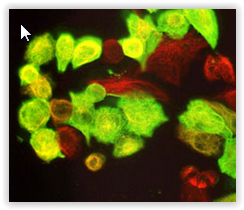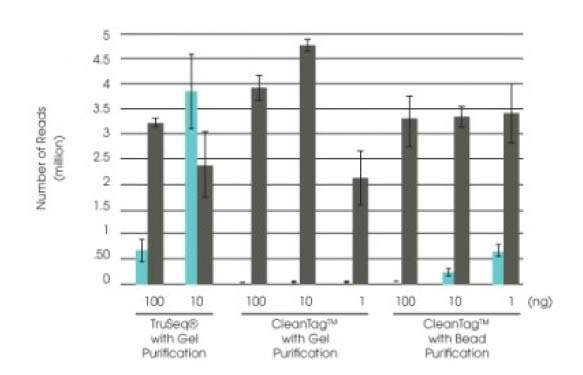
Gaussia Luciferase (GLuc) is a widely accepted gene reporter system used in cell-based assays for various applications (eg. high throughput identification of compounds against viral infections, dose-dependent & pathway-specific inhibitor screenings, functional characterisation of GPCRs, transcriptional activity studies…).
Recently, a modified version (mGLuc) has become available to obtain even more stable and sensitive readout (Figure 1).Each and every new Luciferase reporter assay to be developed requires numerous preliminary assays to test various experimental conditions. This assay development enables researchers to set the most appropriate experimental conditions to obtain biologically relevant and reproducible data. This is even more more important with Luc end-point assays, which additionally require cell lysis for the readout.
But this has become a thing of the past…
Now, the assay development of Luciferase reporter assays is no longer a challenging and tedious stage.

How is this possible? Well, you might consider real-time analysis GLuc gene reporter systems instead of end-point measurement. The new GLuc systems can also integrate a second gene reporter (aka tracking gene as the internal control) for signal normalization.
Develop your cell-based assay with real-time GLuc detection
GLuc-ON™ reporter systems are ideal for promoter analysis by detecting the real-time activity without cell lysis and directly in the supernatant of your cell cultures (see Figure 2).
Thousands of pre-designed and ready-to-transfect vectors are already available (sequences are made according to the NCBI). These clones encode for the secreted GLuc (explaining the fact that cell lysis is not needed anymore) for real-time data acquisition. Results obtained are of biological relevance since these vectors also encode for Secreted Alkalin Phosphatase (SEAP), the secreted tracking gene (for data normalization).

Figure 3 shows normalized data reflecting the activity of 4 promoters (plus transfection controls) in H1B1B and HEK293T cells, respectively 24 hours and 48 hours after transfection.
The system can even be used to study how the promotor sequences work by comparison with custom mutated versions.
Pathway-specific Transcriptional Activity measured by Live Cell GLuc gene reporter assays
If you want to explore promoter activities of a specific cell signaling pathway, you might be interested in the ready-to-transfect Transcriptional Response Element (TRE) GLuc promoter clones recently designed by Genecopoeia. GLuc-ON™ TRE clones enable rapid and sensitive signal pathway analysis in mammalian cell lines using secreted GLuc.
A few examples of available pathways:
- CREB-specific Transcriptional Response Element clone for cAMP/PKA signaling pathway
- NFAT-specific Transcriptional Response Element clone for PKC/Ca++ signaling pathway
- TCF/LEF-specific Transcriptional Response Element clone for Wnt signaling pathway
- Oct4-specific Transcriptional Response Element clone for Oct4 signaling pathway
- HNF4-specific Transcriptional Response Element clone for HNF4 signaling pathway
- JNK-specific Transcriptional Response Element clone for SAPK/JNK signaling pathway
- PKC-specific Transcriptional Response Element clone for PKC/MAPK signaling pathway
- EGR1-specific Transcriptional Response Element clone for EGR1 pathway
- SRE-specific Transcriptional Response Element clone for MAPK/ERK signaling pathway
- MEF2-specific Transcriptional Response Element clone for MEF2 signaling pathway
- ERSE-specific Transcriptional Response Element clone for ER stress pathway
This is very useful for drug screening or target validation on canonical pathways like Wnt and the Endoplasmic Reticulum (ER) stress pathway as illustrated in Figures 4 and 5.


Keen to develop new reporter assays? Looking for biologically relevant pathway- or gene-specific promoter activities?
From robust Secrete-Pair Gaussia Luciferase Dual (GLUC & SEAP) and Single (GLuc) Luminescence detection kits to pre-designed vectors (20,000 human and 18,000 mouse promoters are already available) or cell-based assay development outsourcing, tebu-bio’s experts can assist you. Feel free to leave a message below or to contact your local tebu-bio office to further discuss your projects.
Subscribe to tebu-bio’s Molecular Biology eNewsletter here.



